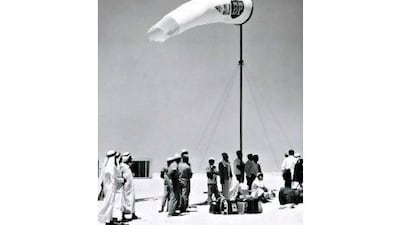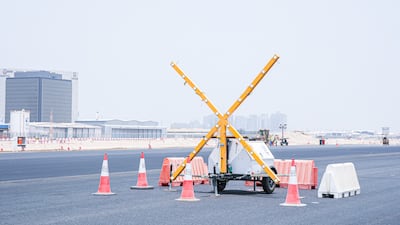Al Bateen Executive Airport in Abu Dhabi will reopen on Saturday following the completion of a major upgrade project.
A senior official at Abu Dhabi Airports on Wednesday told The National that the expansion ― particularly widening the runway ― will allow the airport to formally handle larger aircraft.
Other works undertaken since the private jet facility closed for all but helicopters on May 11 include a substantial new boundary wall, runway resurfacing, upgraded ground lighting, enhanced signage and landscaping.
“It has been a major project involving different elements of the airport,” said Matar Al Suwaidi, senior vice president of terminal operations at Abu Dhabi Airports.
“Everything you can see and touch is being enhanced.”
Airport ushers in new era
The refurbishments mark a new era for an airport that was the first modern international facility in Abu Dhabi.
Al Bateen opened in the late 1960s to cater for a surge in people arriving into Abu Dhabi after oil was found. It replaced the sand airstrip, had a distinctive concrete-roofed terminal and even gave its name to “Airport Road”, which has since been renamed Sheikh Rashid bin Saeed Street.
But it was clear even by the 1970s that demand in Abu Dhabi was likely to necessitate a much larger facility. “Al Bateen is at the heart of Abu Dhabi and on the island, so expansion would be limited. The leadership foresaw the airport [needed] to be moved away from[the] island,” Mr Al Suwaidi said.
The current main airport opened in 1982 to cater for increased demand, and, in the years since, Al Bateen functioned as a military base before becoming a dedicated airport for private jets.
It is also getting ready to host Abu Dhabi Air Expo from November 1 to 3. The event is expected to attract more than 18,000 visitors and host more than 300 manufacturers and suppliers.
The project has been timely in this regard because the runway will change from a 4C to a 4D ― in airport terminology ― which means it can handle twin aisle jets, such as Boeing 767s, whereas before it could only accommodate single aisle planes such as Boeing 737s or Airbus A320s.
Twin aisle jets would have landed at Bateen before but this required permission from the UAE's General Civil Aviation Authority. Certifying the airport as a 4D means certain types of twin-aisles can land without needing this permission.
But the works alone do not award the certification and the authority will give its final approval.
“It is not a switch-on and switch-off decision,” Mr Al Suwaidi said. “There is documentation to provide and testing to conclude. It will take some time.”
It is also planned to rename the three existing terminals before the end of the year as part of a branding initiative to further boost the airport.
“There is a very high demand for a [private jet] facility,” Mr Al Suwaidi said.
Al Bateen can accommodate 50 parked jets and the people who use the facility include government delegations, business people and high-net-worth individuals from across the world who prize discretion and do want the hassle of flying through a main airport.
"The business model is you have more privacy and the moment you get off the plane [at Bateen] and into the car is 100 metres,” Mr Al Suwaidi said.
“[Some people] are not interested in going to the duty free and from one terminal to another. Here everything is done in one place. A one-stop shop.”
The airport can also accommodate helicopters, with Abu Dhabi Police, a search-and-rescue service and private operator among those based there.
A cost for the works was not disclosed, while final tests are now being carried out before Saturday’s opening.
Abu Dhabi's rich aviation history - in pictures
UAE currency: the story behind the money in your pockets
The Voice of Hind Rajab
Starring: Saja Kilani, Clara Khoury, Motaz Malhees
Director: Kaouther Ben Hania
Rating: 4/5
UAE currency: the story behind the money in your pockets
KILLING OF QASSEM SULEIMANI
MEYDAN CARD
6.30pm Maiden Dh165,000 (Dirt) 1,600m
7.05pm Conditions Dh240,000 (D) 1,600m
7.40pm Handicap Dh190,000 (D) 2,000m
8.15pm Handicap Dh170,000 (D) 2,200m
8.50pm The Entisar Listed Dh265,000 (D) 2,000m
9.25pm The Garhoud Sprint Listed Dh265,000 (D) 1,200m
10pm Handicap Dh185,000 (D) 1,400m
The National selections
6.30pm Majestic Thunder
7.05pm Commanding
7.40pm Mark Of Approval
8.15pm Mulfit
8.50pm Gronkowski
9.25pm Walking Thunder
10pm Midnight Sands
THE BIO
Bio Box
Role Model: Sheikh Zayed, God bless his soul
Favorite book: Zayed Biography of the leader
Favorite quote: To be or not to be, that is the question, from William Shakespeare's Hamlet
Favorite food: seafood
Favorite place to travel: Lebanon
Favorite movie: Braveheart
Know your cyber adversaries
Cryptojacking: Compromises a device or network to mine cryptocurrencies without an organisation's knowledge.
Distributed denial-of-service: Floods systems, servers or networks with information, effectively blocking them.
Man-in-the-middle attack: Intercepts two-way communication to obtain information, spy on participants or alter the outcome.
Malware: Installs itself in a network when a user clicks on a compromised link or email attachment.
Phishing: Aims to secure personal information, such as passwords and credit card numbers.
Ransomware: Encrypts user data, denying access and demands a payment to decrypt it.
Spyware: Collects information without the user's knowledge, which is then passed on to bad actors.
Trojans: Create a backdoor into systems, which becomes a point of entry for an attack.
Viruses: Infect applications in a system and replicate themselves as they go, just like their biological counterparts.
Worms: Send copies of themselves to other users or contacts. They don't attack the system, but they overload it.
Zero-day exploit: Exploits a vulnerability in software before a fix is found.
Volvo ES90 Specs
Engine: Electric single motor (96kW), twin motor (106kW) and twin motor performance (106kW)
Power: 333hp, 449hp, 680hp
Torque: 480Nm, 670Nm, 870Nm
On sale: Later in 2025 or early 2026, depending on region
Price: Exact regional pricing TBA
More from Neighbourhood Watch:
The years Ramadan fell in May
Packages which the US Secret Service said contained possible explosive devices were sent to:
- Former first lady Hillary Clinton
- Former US president Barack Obama
- Philanthropist and businessman George Soros
- Former CIA director John Brennan at CNN's New York bureau
- Former Attorney General Eric Holder (delivered to former DNC chair Debbie Wasserman Schultz)
- California Congresswoman Maxine Waters (two devices)
Results
Men's finals
45kg:Duc Le Hoang (VIE) beat Zolfi Amirhossein (IRI) points 29-28. 48kg: Naruephon Chittra (THA) beat Joseph Vanlalhruaia (IND) TKO round 2.
51kg: Sakchai Chamchit (THA) beat Salam Al Suwaid (IRQ) TKO round 1. 54kg: Veerasak Senanue (THA) beat Huynh Hoang Phi (VIE) 30-25.
57kg: Almaz Sarsembekov (KAZ) beat Tak Chuen Suen (MAC) RSC round 3. 60kg: Yerkanat Ospan (KAZ) beat Ibrahim Bilal (UAE) 30-27.
63.5kg: Abil Galiyev (KAZ) beat Nouredine Samir (UAE) 29-28. 67kg: Narin Wonglakhon (THA) beat Mohammed Mardi (UAE) 29-28.
71kg: Amine El Moatassime (UAE) w/o Shaker Al Tekreeti (IRQ). 75kg: Youssef Abboud (LBN) w/o Ayoob Saki (IRI).
81kg: Ilyass Habibali (UAE) beat Khaled Tarraf (LBN) 29-28. 86kg: Ali Takaloo (IRI) beat Emil Umayev (KAZ) 30-27.
91kg: Hamid Reza Kordabadi (IRI) beat Mohamad Osaily (LBN) RSC round 1. 91-plus kg: Mohammadrezapoor Shirmohammad (IRI) beat Abdulla Hasan (IRQ) 30-27.
Women's finals
45kg: Somruethai Siripathum (THA) beat Ha Huu Huynh (VIE) 30-27. 48kg: Thanawan Thongduang (THA) beat Colleen Saddi (PHI) 30-27.
51kg: Wansawang Srila Or (THA) beat Thuy Phuong Trieu (VIE) 29-28. 54kg: Ruchira Wongsriwo (THA) beat Zeinab Khatoun (LBN) 30-26.
57kg: Sara Idriss (LBN) beat Zahra Nasiri Bargh (IRI) 30-27. 60kg: Kaewrudee Kamtakrapoom (THA) beat Sedigheh Hajivand (IRI) TKO round 2.
63.5kg: Nadiya Moghaddam (IRI) w/o Reem Al Issa (JOR).
Is it worth it? We put cheesecake frap to the test.
The verdict from the nutritionists is damning. But does a cheesecake frappuccino taste good enough to merit the indulgence?
My advice is to only go there if you have unusually sweet tooth. I like my puddings, but this was a bit much even for me. The first hit is a winner, but it's downhill, slowly, from there. Each sip is a little less satisfying than the last, and maybe it was just all that sugar, but it isn't long before the rush is replaced by a creeping remorse. And half of the thing is still left.
The caramel version is far superior to the blueberry, too. If someone put a full caramel cheesecake through a liquidiser and scooped out the contents, it would probably taste something like this. Blueberry, on the other hand, has more of an artificial taste. It's like someone has tried to invent this drink in a lab, and while early results were promising, they're still in the testing phase. It isn't terrible, but something isn't quite right either.
So if you want an experience, go for a small, and opt for the caramel. But if you want a cheesecake, it's probably more satisfying, and not quite as unhealthy, to just order the real thing.
The specs
Engine: 1.5-litre 4-cylinder petrol
Power: 154bhp
Torque: 250Nm
Transmission: 7-speed automatic with 8-speed sports option
Price: From Dh79,600
On sale: Now
Dust and sand storms compared
Sand storm
- Particle size: Larger, heavier sand grains
- Visibility: Often dramatic with thick "walls" of sand
- Duration: Short-lived, typically localised
- Travel distance: Limited
- Source: Open desert areas with strong winds
Dust storm
- Particle size: Much finer, lightweight particles
- Visibility: Hazy skies but less intense
- Duration: Can linger for days
- Travel distance: Long-range, up to thousands of kilometres
- Source: Can be carried from distant regions
Low turnout
Two months before the first round on April 10, the appetite of voters for the election is low.
Mathieu Gallard, account manager with Ipsos, which conducted the most recent poll, said current forecasts suggested only two-thirds were "very likely" to vote in the first round, compared with a 78 per cent turnout in the 2017 presidential elections.
"It depends on how interesting the campaign is on their main concerns," he told The National. "Just now, it's hard to say who, between Macron and the candidates of the right, would be most affected by a low turnout."





















